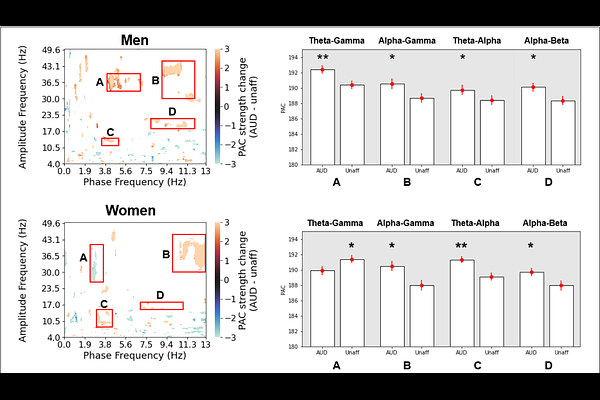Alcohol use disorder is associated with increases in frontocentral phase-amplitude coupling strength during resting state

Alcohol use disorder is associated with increases in frontocentral phase-amplitude coupling strength during resting state
Richard, C. D.; Porjesz, B.; Meyers, J. L.; Bingly, A.; Chorlian, D. B.; Kamarajan, C.; Pandey, G.; Kuang, W.; Pandey, A. K.; Kinreich, S.
AbstractCompromised functional connectivity in the brain seen in fMRI and EEG coherence is a key feature of alcohol use disorder (AUD). Phase-amplitude coupling (PAC) represents another mechanism by which functional connectivity is achieved, and to date, the role played by PAC in understanding the development of AUD has yet to be investigated. In the current study, we compare PAC strengths between participants with severe AUD, defined as presenting with 6 or more symptoms (DSM-5), and unaffected controls. Associations between phase-amplitude coupling and AUD status were assessed using frontal EEG signals acquired during the resting state eyes closed condition as part of the Collaborative Study on the Genetics of Alcoholism (COGA). COGA is a national project following families affected with AUD and comparison families for over 35 years with data collection in multiple domains. COGA participants between 25 and 50 years old with severe AUD were compared to an age-matched group of unaffected controls (Women: N = 360; Men: N = 406). PAC calculations were made on EEG recordings from midfrontal channel FZ to generate high resolution comodulograms covering phase frequencies between 0.1-13 Hz and amplitude frequencies between 4-50 Hz. Comodulograms were generated for each 30 second EEG segment for a given visit. Average comodulogram for a visit was calculated for the first two minutes of EEG in the resting state condition for subsequent statistical analyses. PAC differences between AUD and unaffected controls were assessed at each frequency pair using Mann-Whitney test, and the resulting effect sizes and p-values were used to generate difference comodulograms and significance comodulograms, respectively. Results showed that severe AUD was associated with greater alpha-gamma PAC in both men and women compared to the unaffected groups. Men with AUD exhibited significant increases in PAC across large parts of theta-gamma. In women with AUD, increases in theta-gamma PAC were restricted to smaller domains, and accompanied significant decreases in neighboring theta-gamma subdomains. PAC strength in theta-alpha and alpha-beta frequency pair domains were also significantly greater in AUD for both men and women. The AUD-associated changes in PAC strength within the alpha-gamma, theta-beta, alpha-beta, and to a lesser degree in theta-gamma domains indicates some form of aberrant hyperconnectivity between networks within the medial prefrontal cortex during resting state of the brain.